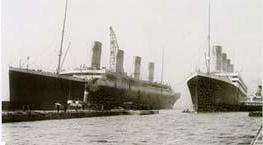Claim: The sister ship to the Olympic and Titanic was originally intended to be named the Gigantic.
Origins: The

Titanic was originally conceived by the White Star Company as one of a triumvirate of ships intended to vie with Cunard for the trans-Atlantic passenger service business. White Star couldn't hope to offer ships as fast as Cunard's liners, so they planned to compete by building liners that were both bigger (and hence able to carry more paying passengers and cargo) and more luxurious than Cunard's. Moreover, since an Atlantic crossing typically took five days in the new class of steamships operated by Cunard and White Star in the first decade of the
The planned ships were so large that the shipbuilders, Harland and Wolff, had to allocate space normally used for building three hulls to handle just two of the new behemoths. Harland and Wolff planned to construct the liners on a staggered schedule so that White Star would have one ready to go into service each spring between 1911 and 1913, and initially everything went according to plan. The keel of the first ship, the Olympic, was laid in December 1908, and the Titanic followed suit three months later. The Olympic was launched in October 1910, and the Titanic in May 1911. The Olympic's maiden voyage took place in June 1911, and the Titanic's in April 1912. And
After the Titanic disaster, the feverish public interest in these massive ocean liners abated, and the third ship of the planned triumvirate, the Britannic, was finally launched (after extensive modifications and with considerably less fanfare than her sisters) in April 1914. Like her sister ship Titanic, she wasn't around long, though: World
1916.
The magnitude of the Titanic disaster and World War I both overshadowed the short life of the Britannic, and she was gone before many people were even aware she had been built. Over the years a rumor began to circulate that the Britannic's original name had been the Gigantic, but White Star had thought better of it and quietly changed their minds after the Titanic sank. White Star maintained that this was not true; they had planned to name the ship Britannic all along and had never considered the name Gigantic.
From a purely logical point of view, Gigantic seems the more likely choice. The names Olympic, Titanic, and Gigantic all evoke a sense of size and strength that Britannic simply does not. And White Star had considered naming a ship Gigantic on at least one other occasion, as demonstrated by this brief article that appeared
She has already been named the Gigantic, and will be
London, Sept. 16 — The White Star Company has commissioned the great Belfast shipbuilders Harland and Wolff to build an Atlantic steamer that will beat the record in size and speed.
We have more than logic and supposition to go by here, however. Contemporary references publications such as The New York Times, Scientific American, and Lloyd's List and Shipping Gazette as well as a promotional flyer from White Star itself all indicate that White Star did indeed originally have the name Gigantic in mind, but one could hardly blame them for altering their plans. After the sinking of the Titanic, passengers were suddenly less concerned with size and luxury than they were with getting to their destinations alive, and the dignified name Britannic conveyed a sense of safety and reliability in a way the attention-grabbing Gigantic could not.
Last updated: 18 December 2005
 Sources:
Sources:
